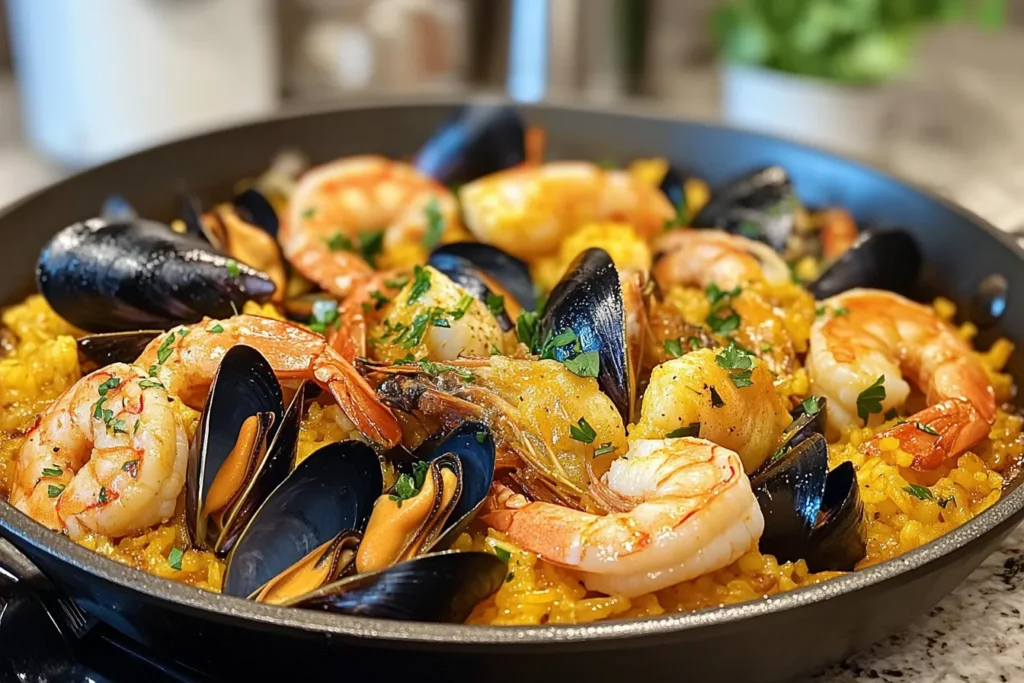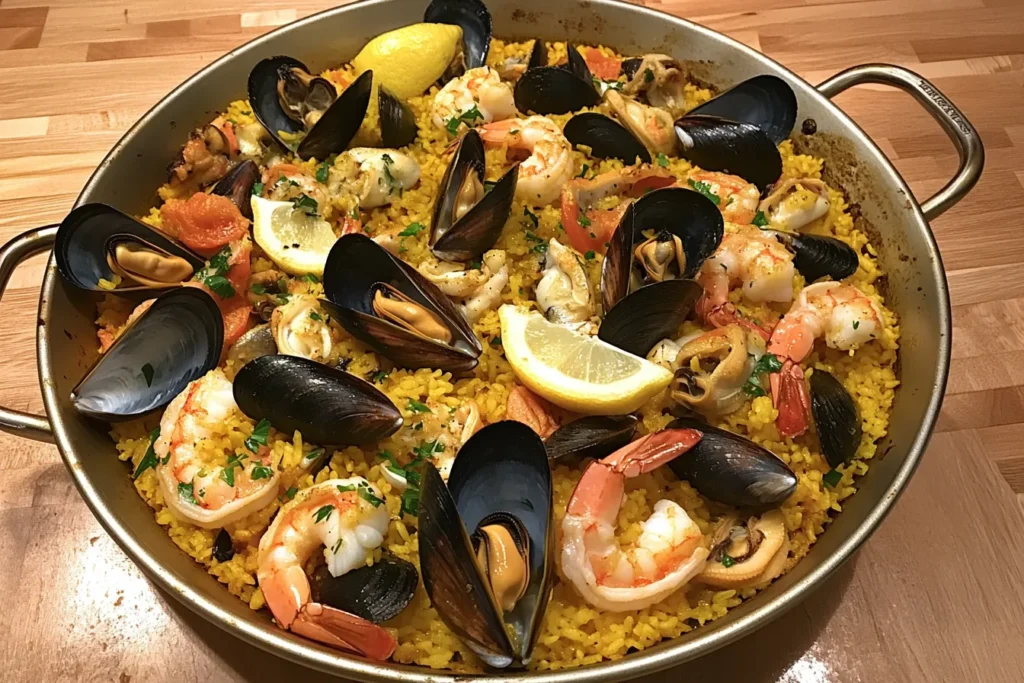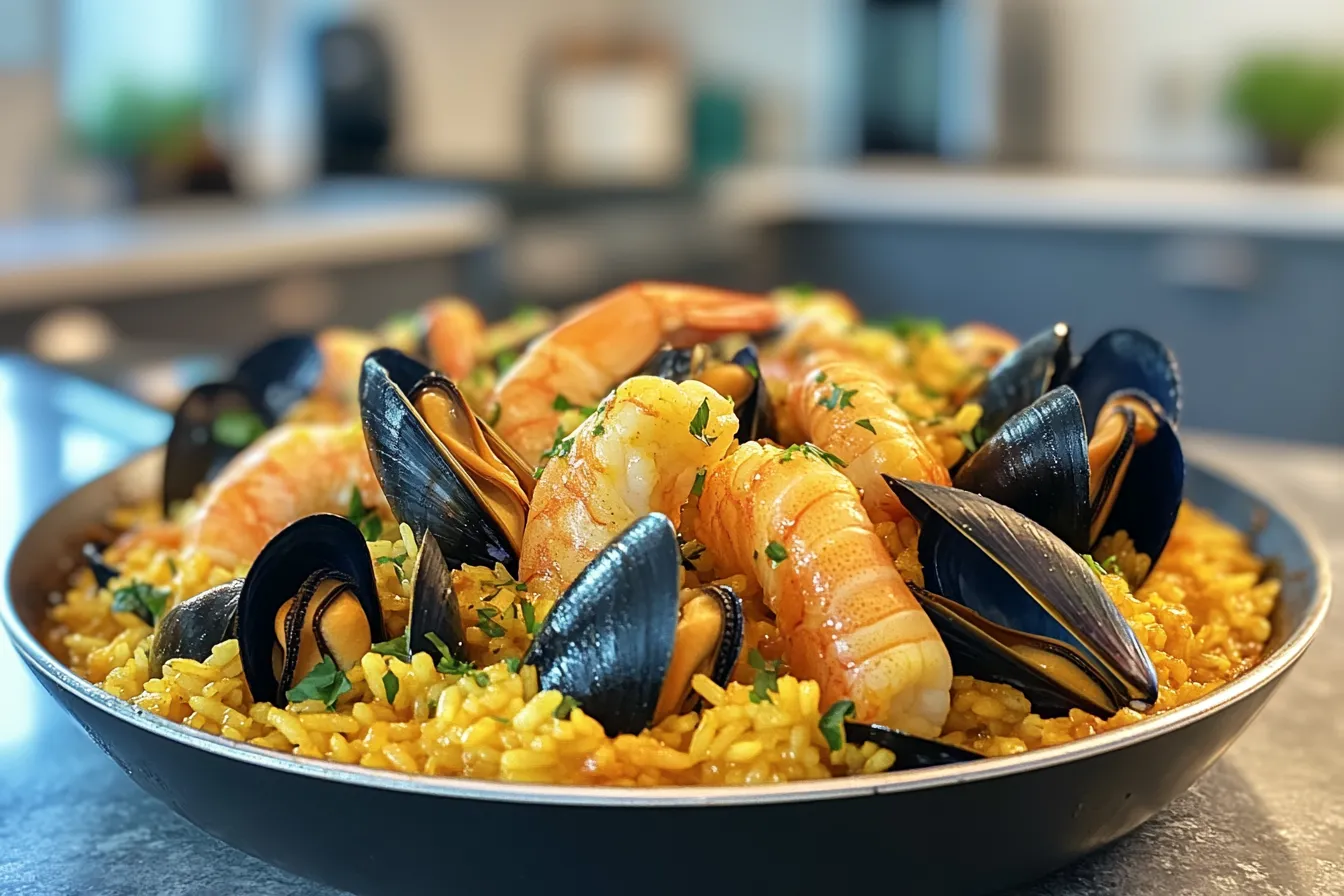Table of Contents
Introduction to Paella de Marisco
What is Paella de Marisco?
Paella de marisco, or seafood paella, is a mouthwatering Spanish dish that has taken the culinary world by storm. It is a heavenly mix of saffron-infused rice and an array of seafood that will make your taste buds do a happy dance. This dish is also the coastal cousin of the traditional Valencian paella, swapping out land-based proteins for the treasures of the sea.
But what sets it apart from other rice dishes? Well, for starters, it is cooked in a wide, shallow pan called a paella, which gives the dish its name. This unique cooking vessel allows for even heat distribution, hence, creating a thin layer of rice that absorbs all the fantastic flavors of the seafood and spices.
The Appeal of Seafood Paella
Why is everyone gaga over this dish? Well, not only is it a feast for the senses, but it also provides a unique dining experience. The vibrant colors, tantalizing aroma, and rich flavors make it a showstopper at any dinner table. Additionally, it is versatile – you can throw in whatever seafood tickles your fancy. Talk about a crowd-pleaser!
Moreover, paella de marisco embodies the essence of Spanish coastal cuisine. It represents a celebration of fresh, local ingredients and time-honored cooking techniques. Each bite tells a story of sun-drenched beaches, bustling fish markets, and generations of culinary expertise.
However, the appeal does not stop there. Paella de marisco is also a social dish. Typically, it is served family-style, straight from the pan, encouraging sharing and conversation. Consequently, it is not just a meal; it’s an experience that brings people together, making it perfect for gatherings and special occasions.
The Origins of Seafood Paella
From Valencia to the Coast
Paella’s roots run deep in Valencia, yet paella de marisco is the rebellious coastal spin-off. As the dish traveled along the Spanish coast, clever cooks swapped rabbits and snails for shrimp and mussels. Et voilà! A star was born.
The original Valencian paella, which emerged in the mid-19th century, was a humble farmer’s dish that combined rice with whatever was available – quite often rabbit, snails, and local vegetables. However, as the dish gained popularity and spread to coastal regions, it underwent a significant transformation.
Coastal communities, endowed with an abundance of fresh seafood, naturally began to incorporate these ingredients into their paellas. This adaptation wasn’t merely about using what was available; it reflected the local culture and lifestyle. The sea was their livelihood, and now it became the star of their signature dish.
Evolution of the Dish
Over time, seafood paella has indeed evolved, with each region adding its own flair. For example, from the briny octopus of Galicia to the succulent red prawns of Dénia, regional variations have made this dish a true Spanish tapestry of flavors.
In the sun-soaked Costa del Sol, you might find paella de marisco brimming with local specialties like boquerones (fresh anchovies) and calamares (squid). Similarly, in the Balearic Islands, sobrassada (a local cured sausage) might make a surprise appearance, adding a unique twist to the seafood medley.
This evolution did not stop at Spain’s borders. As Spanish cuisine gained international acclaim, paella de marisco traveled the globe, adapting to local tastes and available ingredients. For instance, in Japan, you might find a version with added nori (seaweed), while in Louisiana, it is not uncommon to see a paella-jambalaya fusion with the addition of andouille sausage.
Despite these variations, the essence of paella de marisco remains the same – it is a celebration of seafood, rice, and the art of communal dining. Thus, it is a dish that continues to evolve while staying true to its roots, proving that tradition and innovation can indeed go hand in hand.

Key Ingredients for the Perfect Paella de Marisco
Essential Ingredients
When preparing paella de marisco, certain ingredients are indispensable:
- Rice: Bomba or Calasparra rice is preferred due to its ability to absorb liquid without becoming mushy.
- Seafood: A mix of shrimp, mussels, and squid is essential, as each type contributes its own flavor and texture.
- Saffron: Just a pinch is needed for that characteristic golden color and unique flavor.
- Smoked Paprika: This ingredient adds depth and a slight smokiness.
- Olive Oil: Used for sautéing and adding richness.
- Garlic: Minced for flavor.
- Onion: Finely chopped, usually part of the sofrito base.
- Tomatoes: Fresh or canned, they form the base of the sofrito.
- Fish Stock: Provides the necessary liquid and added flavor.
- Lemon: For garnish and a zesty finish.
Optional Ingredients
In addition to the essential ingredients, several optional ones can enhance your dish:
- Bell Peppers: Diced, they add sweetness and color.
- Peas: Fresh or frozen, they contribute a pop of color and freshness.
- White Wine: A splash can enhance the flavor of the broth.
- Chorizo: While not traditional in seafood paella, some people enjoy adding it for extra flavor.
- Fresh Herbs: Parsley or thyme makes a great garnish.
Preparation Guide for Paella de Marisco
Creating a perfect paella de marisco is a rewarding culinary adventure! Here’s a step-by-step guide to get you started.
Step-by-Step Preparation
Gather Your Ingredients: Start by collecting all your essential and optional ingredients. Having everything ready to go will make the cooking process smoother.
Prepare the Sofrito:
- First, heat about 3 tablespoons of olive oil in a large paella pan over medium heat.
- Next, add one chopped onion and sauté until it becomes translucent, which should take about 5 minutes.
- After that, add 3-4 cloves of minced garlic and cook for another minute until fragrant.
- Subsequently, stir in 2 cups of diced tomatoes (fresh or canned) and cook until the mixture thickens, creating a rich, flavorful base.
Add the Rice: Once your sofrito is ready, add 1.5 cups of Bomba or Calasparra rice to the pan. Stir well to coat the grains in the sofrito and toast them slightly for about 1-2 minutes.
Pour in the Stock:
- Now, slowly pour in about 4.5 cups of hot fish stock. Additionally, add a pinch of saffron and 1 teaspoon of smoked paprika at this stage, stirring gently to combine.
- Bring the mixture to a boil, and then reduce the heat to a medium-low setting. Allow it to simmer without stirring for about 10 minutes.
Add the Seafood to paella de marisco
- After the rice has absorbed some liquid, it is time to add your seafood. Arrange 10-12 shrimp, 1 cup of mussels, and 1-2 cups of squid on top of the rice. Furthermore, you can also add clams or any other seafood you prefer.
- Gently press the seafood into the rice without stirring.
Create the Socarrat: To achieve the socarrat, increase the heat to medium-high for the last 2-3 minutes of cooking. At this point, you should listen for a crackling sound, which indicates that the bottom rice layer is crisping up. Be careful not to burn it!
Rest and Serve:
- Once done, remove the pan from heat and let it rest for about 5-10 minutes. This allows the flavors to meld together.
Cooking Techniques and Tips
The Perfect Paella Pan
A wide, shallow paella pan is key. It ensures even cooking and helps create that coveted socarrat – the crispy bottom layer that’s pure gold for paella lovers.
The traditional paella pan, also called a paellera, is wide and shallow with sloping sides. This design serves several purposes. Firstly, it maximizes the surface area, allowing the rice to cook in a thin layer. This is crucial for achieving the perfect texture – each grain of rice should be separate and infused with flavor.
Additionally, the wide surface area promotes evaporation, which concentrates the flavors as the liquid reduces. Finally, the shape of the pan is ideal for forming the socarrat, that deliciously crispy layer of rice at the bottom, which is considered the hallmark of a well-made paella.
If you don’t have a paella pan, don’t worry! A large, wide skillet can work in a pinch. Therefore, the key is to choose a pan that allows the rice to cook in a layer no more than an inch deep.
The Art of Layering
Building flavors is crucial. Start with your sofrito, add the rice, then the stock, and finally the seafood. It’s like conducting a culinary orchestra – timing is everything!
Begin by sautéing your sofrito until it’s thick and fragrant. This creates a base of flavor that will infuse the entire dish. Next, add the rice, stirring to coat each grain with the sofrito. This step is essential for developing depth of flavor.
Then comes the stock, which should be hot when added to maintain the temperature of the pan. The general rule of thumb is to use about 3 cups of liquid for every cup of rice, but this can vary depending on the specific rice you’re using.
Furthermore, add the saffron at this stage, crumbling it into the hot stock to release its flavor and color. Now comes the hands-off part – let the rice cook undisturbed for about 10 minutes before adding the seafood.
The No-Stir Rule
Here’s a shocker – don’t stir the paella once the rice is in! Let it do its thing. This hands-off approach helps form that delicious socarrat we talked about earlier.
This might go against everything you’ve learned about cooking rice, but trust the process. Stirring the rice releases starch, which can make the paella gummy. It also prevents the formation of the socarrat.
Instead of stirring, you can gently shake the pan occasionally to ensure even cooking. If some areas seem to be cooking faster than others, you can rotate the pan on the heat source.
As the liquid evaporates and the rice nears doneness, you might hear a faint crackling sound. This is a good sign – it means the socarrat is forming. At this point, you can slightly increase the heat for the last few minutes of cooking to encourage that crispy bottom layer.
Remember, patience is key. A good paella takes time, but the result is well worth the wait.

Nutritional Value of Paella de Marisco
Paella de marisco isn’t just a treat for your taste buds; it’s packed with nutrients too! Check out this nutritional breakdown (per serving):
| Nutrient | Amount |
|---|---|
| Calories | 450 |
| Protein | 25g |
| Carbs | 65g |
| Fat | 10g |
| Fiber | 3g |
| Iron | 15% |
| Vitamin C | 20% |
It’s a balanced meal that’ll certainly keep you fueled and satisfied. Who said delicious can’t be nutritious?
Let’s break this down a bit further. The high protein content comes primarily from the seafood, which is also an excellent source of omega-3 fatty acids. These healthy fats are known for their anti-inflammatory properties and potential heart health benefits.
The carbohydrates primarily come from the rice, providing energy for your body. Although the fiber content is not particularly high, it contributes to digestive health and helps you feel full longer.
Iron, essential for oxygen transport in the blood, is found in good amounts thanks to the seafood, particularly shellfish. The vitamin C content, likely from the vegetables in the sofrito and any added peas or bell peppers, aids in iron absorption and supports immune function.
It is worth noting that the nutritional content can vary based on the specific ingredients used and their proportions. For example, adding more vegetables can increase the fiber and vitamin content, while using fatty fish like salmon could boost the omega-3 levels.
Moreover, paella de marisco is typically lower in fat compared to meat-based paellas, thus making it a heart-healthy choice. The use of olive oil, a staple in Mediterranean cuisine, provides healthy monounsaturated fats.
While paella de marisco is nutrient-dense, it’s also calorie-dense, so portion control is key if you’re watching your calorie intake. Nevertheless, it’s not just about the numbers – it’s about enjoying a satisfying, culturally rich meal that nourishes both body and soul.
Pairing and Serving Suggestions
Wine Pairings
A crisp Albariño or a chilled Verdejo pairs beautifully with seafood paella. Their citrusy notes complement the dish perfectly. Cheers to that!
Albariño, a white wine from the Rías Baixas region in Galicia, is a popular choice. Its high acidity and mineral notes make it an excellent match for seafood. The wine’s citrus and stone fruit flavors enhance the briny flavors of the shellfish without overpowering the delicate seafood.
Verdejo, hailing from the Rueda region, is another fantastic option. It is known for its herbaceous notes and hints of fennel, which complement the aromatic components of the paella. Its crisp acidity cuts through the richness of the dish, cleansing the palate between bites.
If you prefer red wine, a light, chilled red like a Garnacha (Grenache) from Navarra can work well, especially if your paella includes chorizo or other meats alongside the seafood.
For those who prefer non-alcoholic options, a sparkling water with a slice of lemon can be refreshing. The bubbles and citrus notes cleanse the palate, similar to how wine functions.
Serving Tips
Serve your paella straight from the pan for that wow factor. Moreover, garnish with lemon wedges and fresh parsley to add a pop of color and freshness. It’s Instagram-worthy, for sure!
Presentation is key when it comes to paella de marisco. The traditional way to serve it is to bring the entire pan to the table, allowing guests to serve themselves. This communal style of eating is part of the paella experience.
Before serving, arrange the seafood on top of the rice in an attractive pattern. You can create a spiral with the mussels or arrange the shrimp in a star pattern. This not only looks appealing but also ensures everyone gets a fair share of the seafood.
Additionally, do not forget the lemon wedges – a squeeze of fresh lemon juice over the paella just before eating brightens all the flavors and adds a touch of acidity that balances the rich, savory notes of the dish.
Some people enjoy serving alioli, a garlic mayonnaise, on the side. While not traditional, it can be a delicious accompaniment, especially for those who enjoy a garlicky kick with their seafood.
Lastly, timing is crucial. Paella is best served hot, straight from the stove. The socarrat is at its crispiest right after cooking, so do not let it sit too long before serving. Gather your guests around the table before the paella is done, so you can serve it at its peak of perfection.
Conclusion: Why Paella de Marisco is a Must-Try Dish
Paella de marisco isn’t just food; it’s an experience. It brings people together, tells a story of Spanish coastal culture, and satisfies like no other dish can. Whether you’re a seafood aficionado or just dipping your toes in, this dish is sure to make waves at your next meal. Therefore, grab a pan, some fresh seafood, and get cooking – your taste buds will thank you!
Now that you have the complete guide, you’re all set to create your very own delicious paella de marisco. Enjoy every step of the process, from selecting your ingredients to sharing the meal with loved ones!

